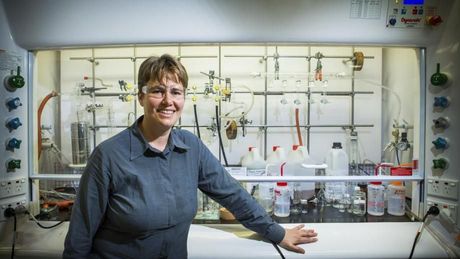Electric fields as catalysts

An Australian-led team of scientists has harnessed static electricity, using an electron microscope as a kind of remote control, to increase the efficiency of the Diels-Alder reaction. This development could have significant impacts on nanotechnology and cleaning up a wide range of industrial applications.
The team managed to harness the static electricity generated by the tip of a scanning-tunnelling electron microscope and use this electric field as the catalyst for the Diels-Alder reaction, in which a conjugated diene and a substituted diene form a cyclohexene system.
Catalysts for such reactions typically involve rare and expensive chemicals which can contaminate the end products and leave polluting by-products.
Electric fields can be controlled from outside the test tube at very high speeds, effectively giving scientists a remote control over complex chemical reactions. The electric field catalyst has the potential to improve the production efficiencies of a wide range of chemicals, including the drug cortisone and a variety of self-healing materials.
The team was brought together under the direction of the ARC Centre of Excellence for Electromaterials Science (ACES). Lead researcher Professor Michelle Coote said, “It’s the most unexpected result possible... we now have a totally new way of thinking about chemistry.”
Professor Coote, who is based at the ANU Research School of Chemistry, had theorised that electric fields could strongly affect reaction rates but this idea had never before been tested. ACES brought together Professor Coote, Dr Simone Ciampi from the University of Wollongong and a team of researchers from Spain’s Universitat de Barcelona in order to devise a way to test Professor Coote’s prediction.
Normally the molecules involved in a standard chemical reaction are randomly oriented within a liquid or gas, making observation of the reaction extremely difficult. The ACES team attached the molecules to a surface, allowing for precise orientation before testing each molecule with the probe of an electron microscope. They were able to vary the rate of the Diels-Alder reaction by a factor of five through careful manipulation of the strength and polarity of the electric field.
Professor Coote believes this breakthrough could have significant impacts in a wide variety of manufacturing processes through an unprecedented level of control over chemical reactions, “for example, in manufacturing flexible electronic components based on organic circuits”.
This research was made possible by the collegial environment and multidisciplinary approach fostered by ACES. Professor Gordon Wallace, the ACES director who brought the team together, said this holistic approach to interdisciplinary research makes it possible to mobilise the diverse skill sets required to take ideas to industries as rapidly as possible.
Published in the latest edition of Nature, Professor Coote hopes that this research can lead to greater understanding of the ways in which natural biochemical reactions use enzymes as catalysts.
Hyperspectral imaging tech selected for homeland security
Living Optics has been selected by Singapore Homeland Security to demonstrate its advanced...
Benchtop NMR used to assess heart disease risk
The breakthrough will enable more accessible, high-throughput cardiovascular disease (CVD) risk...
Activated gold helps visualise drug movement in the body
Gold nanoparticles are promising drug carriers for cancer therapy and targeted drug delivery, but...




